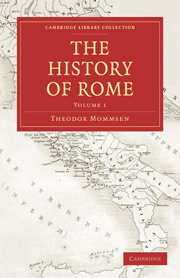Book contents
- Frontmatter
- PREFACE
- PREFATORY NOTE BY THE TRANSLATOR
- EXTRACT FROM DR. MOMMSEN'S PREFACE
- Contents
- BOOK FIRST THE PERIOD ANTERIOR TO THE ABOLITION OF THE MONARCHY
- BOOK SECOND FROM THE ABOLITION OF THE MONARCHY IN ROME TO THE UNION OF ITALY
- CHAPTER I CHANGE OF THE CONSTITUTION.—LIMITATION OF THE POWER OF THE MAGISTRATE
- CHAPTER II THE TRIBUNATE OF THE PLEBS AND THE DECEMVIRATE
- CHAPTER III THE EQUALIZATION OF THE ORDERS AND THE NEW ARISTOCRACY
- CHAPTER IV FALL OF THE ETRUSCAN POWER. THE CELTS
- CHAPTER V SUBJUGATION OF THE LATINS AND CAMPANIANS BY ROME
- CHAPTER VI STRUGGLE OF THE ITALIANS AGAINST ROME
- CHAPTER VII THE STRUGGLE BETWEEN PYRRHUS AND ROME
- CHAPTER VIII LAW. RELIGION. MILITARY SYSTEM. ECONOMIC CONDITION. NATIONALITY
- CHAPTER IX ART AND SCIENCE
- APPENDIX: ON THE PATRICIAN CLAUDII
- ADDITIONS AND CORRECTIONS
CHAPTER III - THE EQUALIZATION OF THE ORDERS AND THE NEW ARISTOCRACY
Published online by Cambridge University Press: 05 October 2010
- Frontmatter
- PREFACE
- PREFATORY NOTE BY THE TRANSLATOR
- EXTRACT FROM DR. MOMMSEN'S PREFACE
- Contents
- BOOK FIRST THE PERIOD ANTERIOR TO THE ABOLITION OF THE MONARCHY
- BOOK SECOND FROM THE ABOLITION OF THE MONARCHY IN ROME TO THE UNION OF ITALY
- CHAPTER I CHANGE OF THE CONSTITUTION.—LIMITATION OF THE POWER OF THE MAGISTRATE
- CHAPTER II THE TRIBUNATE OF THE PLEBS AND THE DECEMVIRATE
- CHAPTER III THE EQUALIZATION OF THE ORDERS AND THE NEW ARISTOCRACY
- CHAPTER IV FALL OF THE ETRUSCAN POWER. THE CELTS
- CHAPTER V SUBJUGATION OF THE LATINS AND CAMPANIANS BY ROME
- CHAPTER VI STRUGGLE OF THE ITALIANS AGAINST ROME
- CHAPTER VII THE STRUGGLE BETWEEN PYRRHUS AND ROME
- CHAPTER VIII LAW. RELIGION. MILITARY SYSTEM. ECONOMIC CONDITION. NATIONALITY
- CHAPTER IX ART AND SCIENCE
- APPENDIX: ON THE PATRICIAN CLAUDII
- ADDITIONS AND CORRECTIONS
Summary
Union of the plebeians.
The tribunician movement appears to have mainly originated in social rather than political discontent, and there is good reason to suppose that some of the wealthy plebeians admitted to the senate were no less opposed to that movement than the patricians. For they shared in the privileges against which the movement was mainly directed; and although in other respects they found themselves treated as inferior, it probably seemed to them by no means an appropriate time for asserting their claim to participate in the magistracies, when the exclusive financial power of the whole senate was assailed. This explains why during the first fifty years of the republic no step was taken aiming directly at the political equalization of the orders.
But this league between the patricians and wealthy plebeians by no means bore within it any security for its permanence. Beyond doubt from the very first some of the leading plebeian families had attached themselves to the movement-party, partly from a sense of what was due to the fellow-members of their order, partly in consequence of the natural bond which unites all who are treated as inferior, and partly because they perceived that concessions to the multitude were inevitable in the issue, and that, if turned to due account, they would result in the abrogation of the exclusive rights of the patriciate, and would thereby give to the plebeian aristocracy the decisive preponderance in the state.
- Type
- Chapter
- Information
- The History of Rome , pp. 296 - 328Publisher: Cambridge University PressPrint publication year: 2010First published in: 1862

